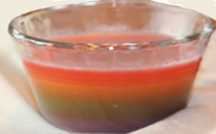We started out with a chemistry magic show...
1. Lighting a dollar bill on fire... but it didn't burn!
 |
| (It was soaked in a 50% alcohol solution) |
2. Changing "water" into all kinds of colours with my magic potion (purple cabbage juice).
 |
| Left to right: water, vinegar, baking soda & water. Just add water from boiling purple cabbage- nature's own acid-base indicator! |
 |
| You can actually SEE it changing as a poured it in. Click on pic to enlarge. |
3. Disappearing water trick
 |
| Poured water in one of the cups...which one was it? |
 |
| They were all empty! |
 |
| There was poly-acrylate power in one of the cups- same stuff they put in diapers- it turns the water to an instant gel and sticks to the inside of the styrofoam cup. They were dumbfounded!!! |
 |
Our lame version of elephant's toothpaste. (on right) Need 30% hydrogen peroxide to really make it go. See below: |
Green batch not as good as blue batch. Make sure to measure the ingredients.
Slime Recipe:
(a) mix 1/2 cup of white glue with 1 cup water, add a few drops of food colouring.
(b) mix 1/2 tsp. Borax with 1/2 cup water
Mix 1 cup of solution (a) with 1/3 cup of solution (b)
3:1 ratio, essentially.
Instant slime, just like the kind you would buy at the store.
Milk art. SO cool and so easy- it is a MUST TRY!
(Especially with that sitting-all-day-in-a-sippy-cup-so-I'm-going-to-pour-it-out milk.)
Pour whole milk into a plate with edges
Drop a few drops of food colouring
Dip a toothpick in dish soap, and touch the food colouring.
The fat in the milk does not mix with the water in the food colouring, and adding soap disperses the fat layer.
The coolest part was that it kept moving and changing for several minutes. It almost looked like it was boiling.
And that was chemistry day!










































